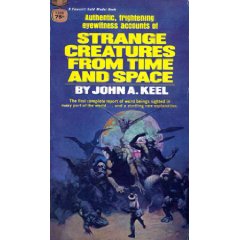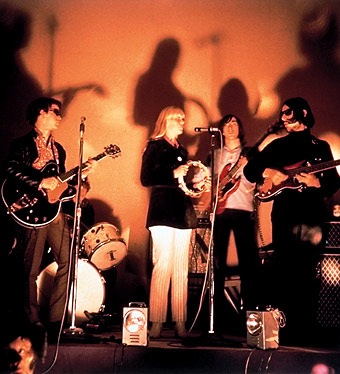|
|
August 09, 2009
John A. Keel 1930-2009 R.I.P. Fortean researcher, journalist and author John Alva Keel died July 3rd at 79. He was best known for his supernatural study "The Mothman Prophecies" (1975), that was made into a film starring Richard Gere in 2002. Fortean researcher, journalist and author John Alva Keel died July 3rd at 79. He was best known for his supernatural study "The Mothman Prophecies" (1975), that was made into a film starring Richard Gere in 2002.
From Cryptomundo: John Alva Keel, 79, a friend, Fortean, fierce fighter for his theories, professionally a writer and journalist, has died. A fellow admirer of Mothman and the anomalies all around us, such as the “name game,” is gone.
Keel, who lived most of his life in New York City, passed away on Friday, July 3, 2009, at Mount Sinai Hospital in New York City, after some months in a nursing home near his Upper West Side apartment.
Born Alva John Kiehle in upstate New York on March 25, 1930, John Keel began writing at a young age. Indeed, Keel’s first published story was in a magician’s magazine at the age of 12.
Keel would go on to become a scriptwriter for radio and television, and a stringer for newspapers. He later moved to Greenwich Village and wrote for various men’s and speciality magazines.
Keel’s first published book was Jadoo in 1957, which was quickly serialized in a men’s adventure magazine. The paperback is his account of his journey of discovery to India to investigate the alleged activities of fakirs and holy men who perform the Indian rope trick and who survive being buried alive. In Jadoo, Keel also told of tracking a Yeti, an Abominable Snowman, in the jungles of Asia.
John A. Keel’s non-fiction look at the very real unplanned twists in life were recorded in his 1966 novel, The Fickle Finger of Fate. It is a rare book, and few realize that Keel wrote this book.
Keel was an early admirer of Charles Fort (1874-1932), and while still doing the mainstream writing, began authoring articles for England’s Flying Saucer Review (FSR) and a long series of columns for Saga.
Further influenced by Fortean Ivan T. Sanderson and ufologist Aimé Michel, in early 1966, John Keel commenced a full-time investigation of monster, aerial and paranormal phenomena. Over a four-year period, Keel interviewed thousands of people in over twenty U.S. states, especially in the Ohio River Valley of the United States. More than 2,000 books were reviewed in the course of his investigation, in addition to thousands of magazines, newsletters, and newspapers. Keel also subscribed to several newspaper-clipping services, which often generated up to 150 clippings for a single day during the 1966 and 1967 UFO “wave.” Besides FSR, Keel wrote for several magazines including Saga with one 1967 article “UFO Agents of Terror” referring to the Men in Black. He also wrote one of the first articles on Mothman in FSR, during this same time period.
Like other contemporary 1960s researchers such as J. Allen Hynek and Jacques Vallée, Keel was initially hopeful that he could somehow validate the prevailing nuts-and-bolts, extraterrestrial visitation hypothesis for UFOs. However, a year into his investigations, Keel realized that the extraterrestrial hypothesis was untenable and did not explain, for him, based within his personality and belief systems, all the answers.
Keel’s insights also included his view of cryptozoology.
I grew to know Keel after being introduced to him through mutual friends Brad Steiger and Ivan Sanderson. I worked closely with Keel on contributing as yet-unpublished material of mine for his book, Strange Creatures from Time and Space (1970), which would influence my and Jerome Clark’s first two books The Unidentified (1975) and Creatures from the Outer Edge (1978).
Keel’s impact is far-reaching. Keel’s book, Strange Creatures from Time and Space was the inspiration for Craig Woolheater’s interest in Bigfoot and eventually would stimulate the creation of Cryptomundo.
Love him or hate him, John Keel was popular and one of the most widely read and influential Fortean authors of the late 20th century. Although his own thoughts about aerial, monster, and associated anomalous phenomena gradually evolved during the 1960s, Keel remained one of ufology’s most original and controversial researchers.
It was Keel’s second book, UFOs: Operation Trojan Horse (1970), that alerted the general public that many aspects of contemporary UFO reports, including humanoid encounters, often paralleled certain ancient folklore and religious encounters. Keel also argued that there is a direct relationship between UFOs and elemental phenomena. Keel informed me often that he did not consider himself a “ufologist,” but a “demonologist.”
Wiki // "John Keel was..." // Evening Tribune // UFO Digest // UFO Mystic // Keel at amazon: Best Of / Mothman / Mysterious Beings / Jadoo
12:49
August 01, 2009
VU singles 7x7 1966-69 News from Sundazed Records, who put out 2008's most acclaimed reissue, the triple vinyl/dbl. CD Dennis Wilson: Pacific Ocean Blue/Bambu album: News from Sundazed Records, who put out 2008's most acclaimed reissue, the triple vinyl/dbl. CD Dennis Wilson: Pacific Ocean Blue/Bambu album:
The Velvet Underground Singles 1966–69
Sundazed is proud to release The Velvet Underground Singles 1966–69, a 7 x 7" single box set honoring the legendary New York combo's 7" vinyl output in their rare mono versions. The set features exact reproductions of Velvet Underground singles, two of them with their original picture sleeves. The singles are packaged in a distinctively designed box, along with rare vintage photos and new liner notes by Rolling Stone's David Fricke (who also penned the acclaimed notes for the historic 1995 Velvets CD box set Peel Slowly and See).
The Velvet Underground—whose membership included Lou Reed, John Cale, Sterling Morrison, Maureen Tucker, Doug Yule and Nico—introduced numerous sonic and thematic innovations that laid much of the groundwork for punk and alternative rock. Although they're now acknowledged as one of the most influential bands in rock history, during their existence the Velvets barely registered on mainstream radar, and were often reviled by mainstream observers as well as hippie-era arbiters of cool. But, as Fricke writes in the new set's liner notes, "Somewhere, in another rock & roll universe, the Velvet Underground are more than a legendary band. They are stars, with hit singles—the original seven-inch masterpieces inside this box."
Although they never came close to scoring a hit, the Velvet Underground was ideally suited to the 7" single format. "The Velvet Underground were a great singles band," David Fricke notes, adding that the Velvets "invented modern rock with searing guitar distortion, throbbing improvisation and brutally realistic tales of life on the wild side. But they did it all in these classic pop songs—compact miracles of raw drive, intimate beauty and Top 40 ecstasy, heard again in the original, thrilling mono single mixes."
The seven singles included in The Velvet Underground Singles 1966–69 comprise the four Velvets singles originally released in the U.S. on the Verve and MGM labels, plus an additional pair of singles that were prepared for release but never made it to the marketplace and a special radio-only promotional single. The singles feature alternate mono versions that differ in significant ways from the songs' better-known stereo album versions. For instance, the band's 1966 debut single "All Tomorrow's Parties" appears here in a special mono edit that amplifies the song's melodic beauty and sonic tension, and a mono mix of their sophomore single "Sunday Morning" emphasizes the song's haunting quality. Meanwhile, the mono single version of "White Light/White Heat" exemplifies the vintage Velvets' stark, distortion-laden fury, while a mono edit of "What Goes On" accentuates that song's inherent pop jangle.
The Velvet Underground Singles 1966–69 also includes two unissued singles, one with a never-released pairing of "White Light/White Heat" backed by "I Heard Her Call My Name," and the other with "Temptation Inside Your Heart" and "Stephanie Says," recorded in the waning days of the band's classic Reed/Cale/Morrison/Tucker lineup and unheard by the public for nearly two decades thereafter. The set's seventh single is a reproduction of a vintage promotional disc, a two-and-a-half minute radio spot promoting the band's eponymous third album and featuring legendary disc jockey Bill "Rosko" Mercer, with excerpts from "I’m Set Free," "What Goes On" and "Beginning to See the Light," as well as a picture sleeve with an un-airbrushed variation on the album's iconic cover art.
Also; New book: White Light/White Heat: The Velvet Underground Day by Day by Richie Unterberger // New in August 09: The Velvet Underground: An Illustrated History of a Walk on the Wild Side by Jim DeRogatis // Upcoming book: The Velvet Underground - A New York Art by Johan Kugelberg // VU site - Electricity Comes From Other PlaNETs // Lou Reed: Metal Machine Trio
14:30
Dark Stars Rising by Shade Rupe Shade Rupe, editor of the art journals "Funeral Party" 1 & 2, has a book of interviews coming out on Headpress this fall: Shade Rupe, editor of the art journals "Funeral Party" 1 & 2, has a book of interviews coming out on Headpress this fall:
DARK STARS RISING - Conversations from the Outer Realms / Format: Paperback / 288 pp (tenative publ. date: Nov. 2009)
Ever wondered if Teller actually talks, tickled yourself over what Divine might do when not consuming inconsumables for film director John Waters, or perhaps even considered the truth about Girls and Corpses, DARK STARS RISING is the one book that demonstrates there is much more to the creative act than merely sitting down for an interview, or not being profiled on MTV.
DARK STARS RISING is a collection of twenty six interviews spanning twenty-three years with various creators of darker art, from America through to Austria and beyond. Working in different art forms and in many cases never meeting or being aware of each other, the main vortex is created here by interviewer and New York film writer Shade Rupe, known for his avant interests and the cultural sector he created with his Funeral Party series of books. Everyone in this collection (with the exception of the late Divine, whose last interview appears in this book, and Brother Theodore) is working today, continuing to produce artifacts that catch the heart, mind and soul.
Many rare photographs are used throughout, plus a resource section lists useful links for further information. A selection of choice reviews rounds out the book.
Interviewees includes: Richard Kern, Alejandro Jodorowksy, Buddy Giovinazzo, Udo Kier, Jim VanBebber, Tura Satana, Teller, Johannes Schonherr, Chas. Balun, Divine, Hermann Nitsch, Genesis P-Orridge, William Lustig, Johanna Went, Zamora, The Torture King, Dame Darcy a.o.
13:35
|
|

